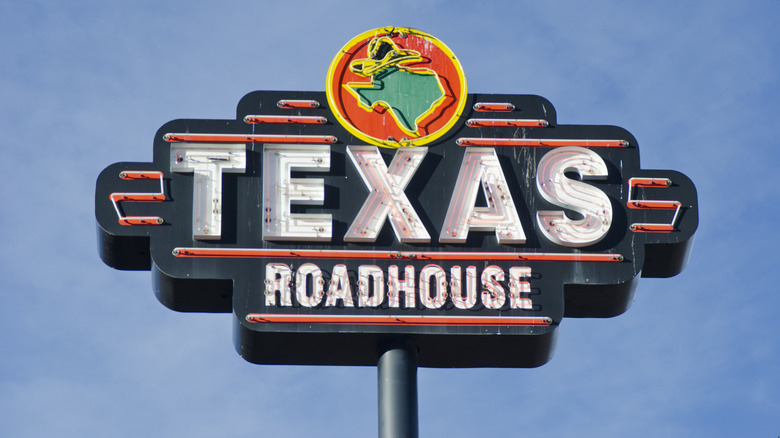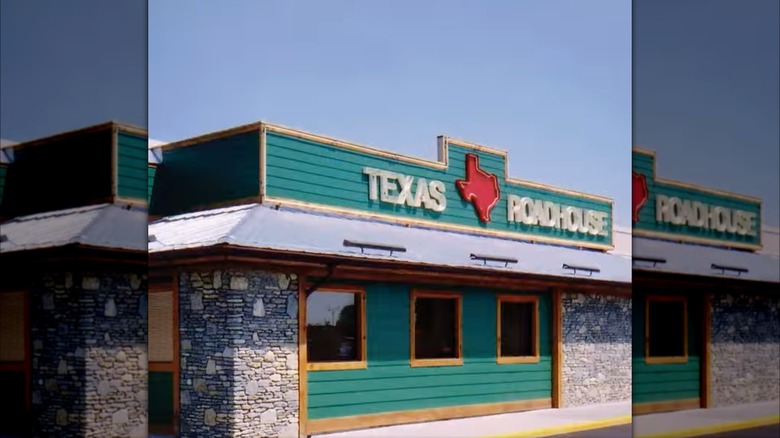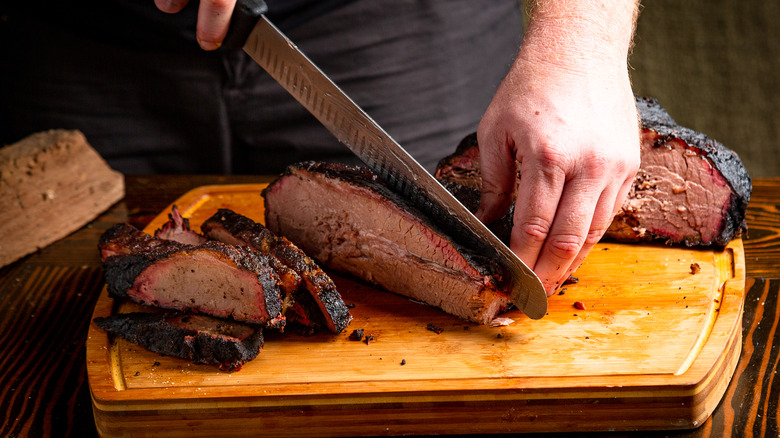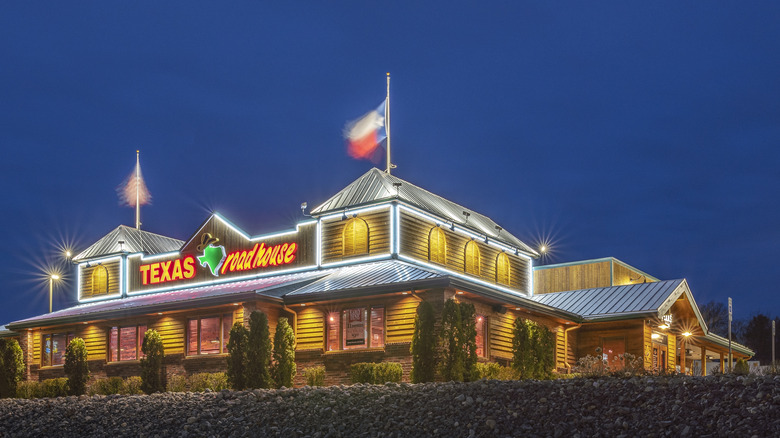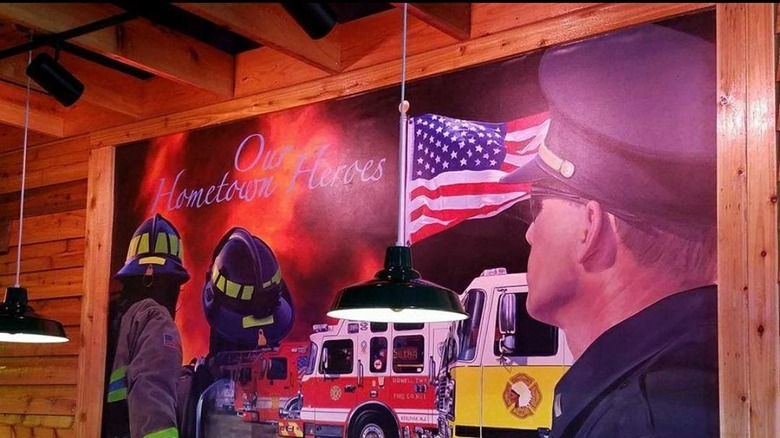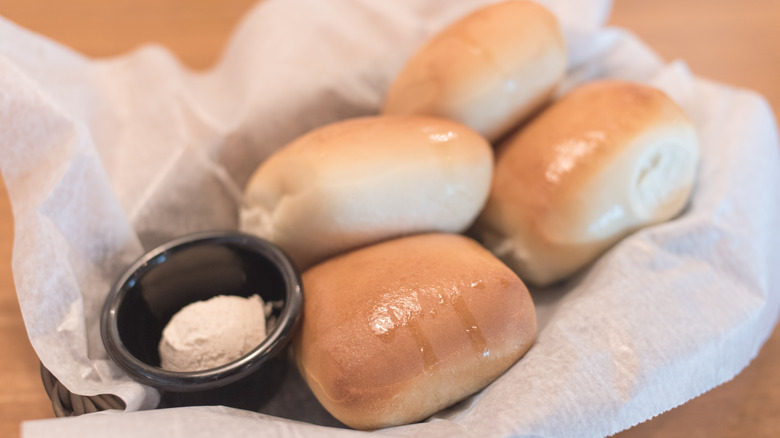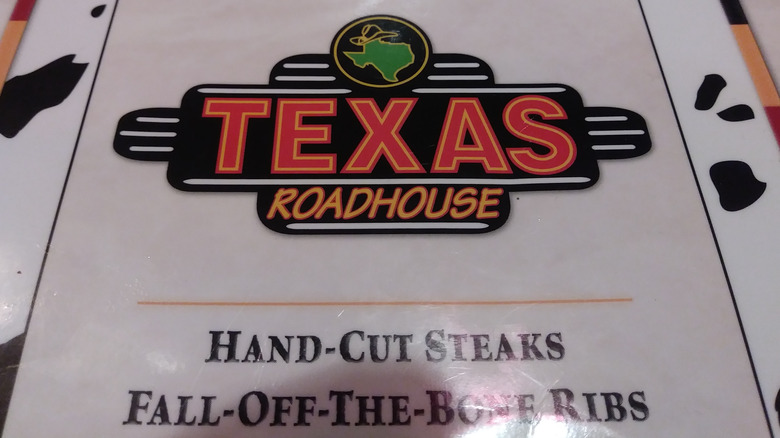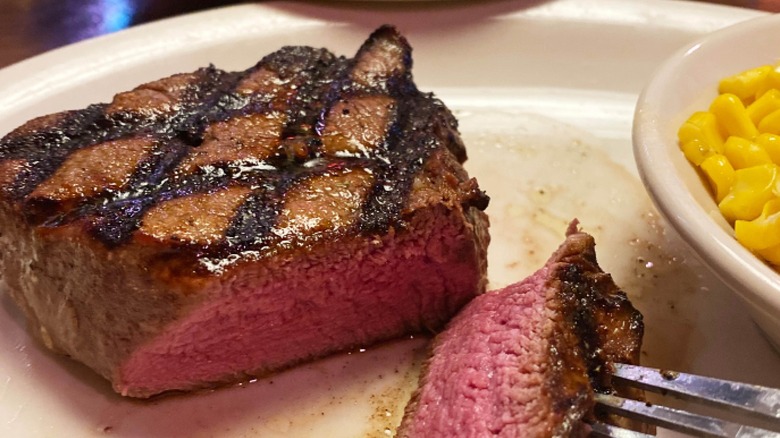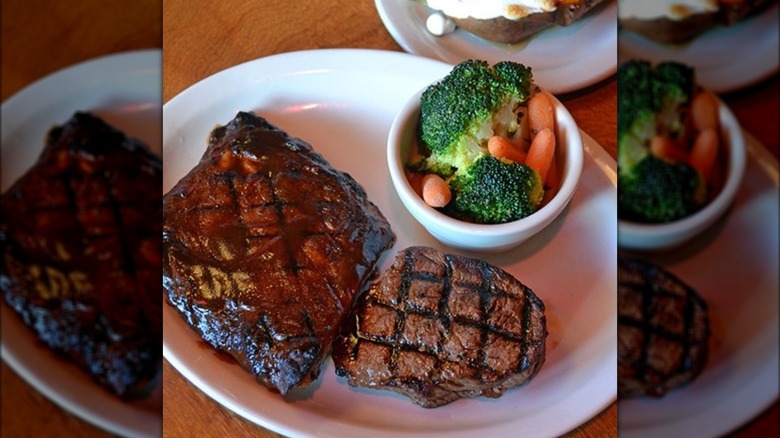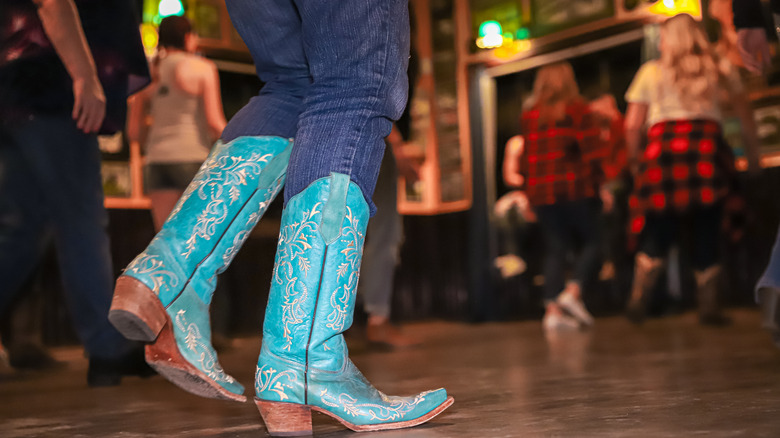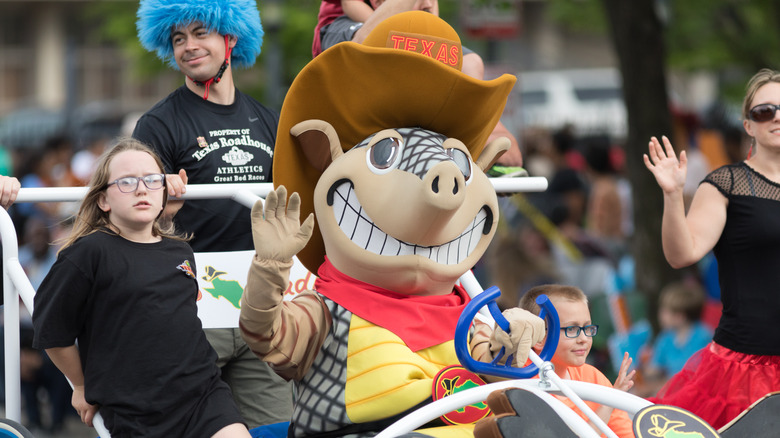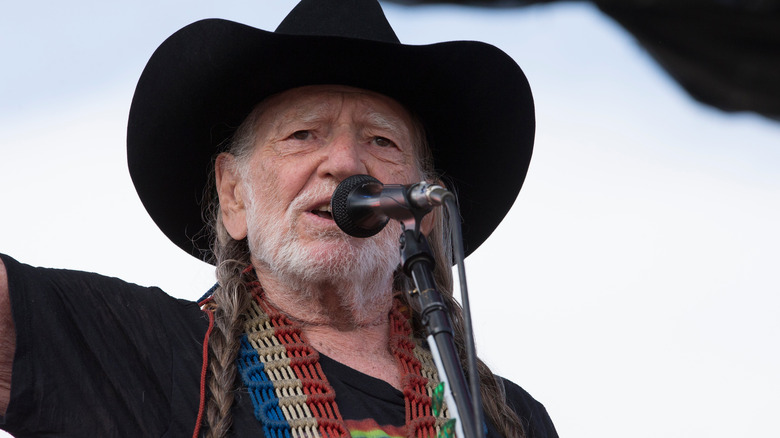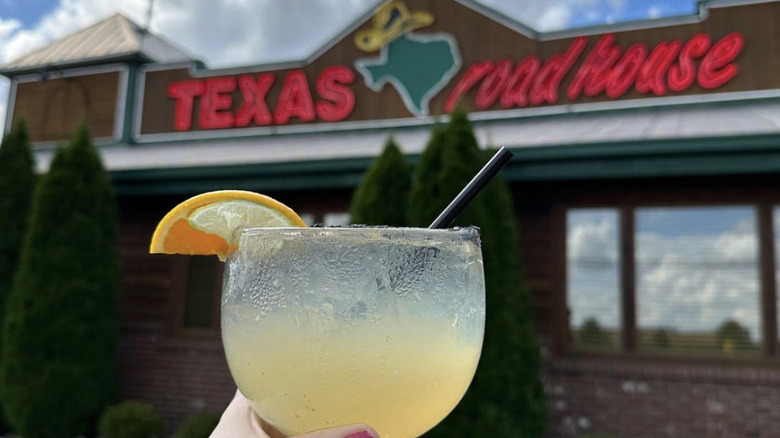What It Was Like To Eat At The First Texas Roadhouse
If you've been to Texas Roadhouse, you're probably familiar with the smell of freshly baked rolls wafting through the air, the lively cowboy theme, and the top-tier steaks making your taste buds dance. What you might not know is that this steakhouse chain is one of the fastest-growing steakhouse chains in the U.S., with over 650 locations in all 50 states.
This restaurant is known for its hand-cut steaks, delicious sides made in-house, legendary margaritas, and fun, family-friendly atmosphere. Since its humble start in 1993, Texas Roadhouse quickly became a chain the year after with three new locations in Indiana, Ohio, and Florida. Now, no matter what state you live in, you can make a drive to one of its locations.
You're probably wondering what that very first Texas Roadhouse location was like and how it became a steakhouse empire so quickly. Let's dive in and take it back to 1993 where it all began.
It first opened in Clarksville, Indiana
You might be surprised to see that the first restaurant wasn't in Texas. Founder Kent Taylor opened the first location when he was almost 40 years old after managing multiple restaurants in the town of Clarksville. Because of his experience working in the restaurant business for so many years, Taylor was passionate about one day starting his very own restaurant. He specifically wanted to create an atmosphere where his employees would be treated extremely well — and he did just that.
After a few failed restaurant ideas, his idea of a Texas-themed restaurant sparked the interest of a few lucky investors. Thus, the journey began, and the first location was finally opened in February 1993. The location in Indiana is right across from the city of Louisville, Kentucky — where the company headquarters are located today. You can visit the original location, which is still open, nestled within a shopping mall.
The food has always been made fresh
One of Taylor's visions for his restaurant was to provide consistently fresh and tasty food. Maintaining one location with this standard shouldn't be an issue, as most stand-alone restaurants make all their food from scratch. However, once an establishment becomes a chain, the food needs to remain consistent across all locations, which makes keeping the standard of freshly made food a bit more difficult. This is why many chain restaurants get pre-made food shipped in from big warehouses. Not Texas Roadhouse, however.
Its steaks are all hand-cut and never frozen. It even has an in-house butcher who hand-cuts all the steaks while working in 34-degree coolers. The famous bread rolls are baked fresh (by its in-house baker) every 5 minutes to ensure soft, warm bread to munch on while waiting for your entrées. Every single item that you order off the menu will be fresh — everything from the dressings on your salads to the mashed potatoes that accompany your steak.
From 1993 to now, Texas Roadhouse has maintained this high standard of food quality. It even talks about its freshly made food through its funny TikTok presence, making sure that nobody forgets this important fact about its restaurants.
The exterior looked nothing like the chain locations look today
Today, Texas Roadhouse has a consistent yet unique look. That way, when you're visiting a new city or on a road trip and see a Texas Roadhouse, you'll recognize it right away. If you see the original location in Clarksville, Indiana, however, you might not recognize it.
These days, you can expect to see a large logo with the state of Texas in an army green color placed in between "Texas" and "Roadhouse". The Texas icon also has a neon yellow cowboy hat perched at the top. The buildings are usually covered in lightwood siding, with a reddish brick on the columns or on the bottom half of the building. Green trim is usually used to outline the building. Many locations have two little peaks in the roof on either side of the logo, adorning a USA flag on one side and a Texas flag on the other.
The original location, however, is fully covered in army green siding. The trim is a light wood color (similar to the wood siding that is now the main exterior of the restaurants today). The logo has the state of Texas in between the words as well, except it is red and doesn't have the cowboy hat. The brick on this location is a gray color that doesn't quite match the vibe of the rest of the building. This original design is a bit disjointed, while the new design is friendly and cohesive.
The roadhouse has always had interesting décor inside each location
All Texas Roadhouses have similar interiors. Light wood paneling covers the walls, neon signs brighten up the space, and wooden booths scatter throughout. The walls are filled with anything from beer posters to cowboy artwork, sports memorabilia, and more. The only major difference from location to location now is that unique, localized décor is strewn across the walls. This décor is used to honor the local community. It's not clear if this specific design aspect was used at the Roadhouse since the beginning, but it's safe to assume that it's been happening for a long time.
There are posters, murals, signs, and photos that cover the walls of each location. To reflect the locals, there are special pieces made. For example, if you are visiting a spot in New Jersey, you may find a mural that is dedicated to the local fire department. If you're stopping for dinner in South Carolina, you might see a mural that represents one of the local universities.
There is even a muralist, David Soileau, who has been commissioned to make a special piece of art for every location that opens. Still to this day, when a new location opens, a unique mural is created to adorn the wall.
Peanuts and bread have always been free
Who doesn't love a free breadbasket at a restaurant? Some of the top restaurants in the US have free bread — and Texas Roadhouse is no different. Originally, the steakhouse took it a step above, and not only offered its iconic bread rolls, but also offered buckets of peanuts for free. Unfortunately, there have been reports that the chain has stopped serving the peanuts at the table. However, you can still ask for a bag of the peanuts to-go — so technically, they're still free.
The reason that these two complimentary items were a part of the experience from day one was founder Kent Taylor. He wanted to establish a family-friendly atmosphere from the moment people were seated, so the customers were immediately served the bread rolls and a big bucket of peanuts. That was a smart way to avoid hangry kiddos, we'd say. Now the customers still get the bread rolls, and the peanuts are treated more like a goody bag to take on your way out.
With the bread rolls being a fan favorite, and the peanuts being a delicious addition, Taylor decided to add even more fun to the mix. Although it's no longer happening in many locations, it was originally customary for patrons to throw their peanut shells straight onto the floor. That not only made it more fun for children, but it also contributed to the cowboy-like theme of the steakhouse.
The menu has stayed consistent
Although we couldn't get our hands on an original 1993 menu, every photo of older menus we did find online showed no major changes in what the restaurant offered. Texas Roadhouse has always known what it was: a steakhouse with a Texas twist. Tanya Robinson, chief financial officer of the company, even said in a panel with The Motley Fool, "When you're someone in the back of the house cooking for us — and you are cooking, because you're making food from scratch, making dressings, mashing potatoes and grilling steaks — you don't have to learn a new recipe every six weeks. We just don't do that, so you get really good at executing on that menu."
At the core, the steakhouse has always offered hearty steaks. Choices range from sirloins, ribeye, filet, and prime rib to New York strips and more. It has also always offered many different weight choices, including the famous 16-ounce Cowboy Cut. Its unique appetizers have stayed strong as well. We found the Rattlesnake Bites, which are fried balls of jack cheese and jalapeños, and Cactus Blossom, which is a fried sliced onion, consistently listed on menus throughout the years.
Beyond the unique appetizers and classic steaks, simple meals have always been offered as well, like chicken tenders, salads, ribs, chicken dishes, seafood, and sandwiches. Since the original intent of the restaurant was to be a great place for the family to gather, it has always offered something for everyone on the menu.
The 6-ounce sirloin has always been the most popular menu item
When taking both affordability and taste into account, the 6-ounce sirloin at Texas Roadhouse is always a great choice. At Texas Roadhouse, it costs $13.99 today, and it was less than $10 in the early 2000s (prices vary depending on location). Considering the steaks at Texas Roadhouse are hand-cut and never frozen, the quality is very high for such a great price.
Chief Financial Officer Tanya Robinson said to The Motley Fool panel, "In 1993, the number one steak was the 6-ounce sirloin. In 2016, the number one selling item is the 6-ounce sirloin." Even recent Tripadvisor reviews say that the sirloin is still the best, keeping it high in the ranking even now. Another customer reviewing a New Jersey location on Google Maps said, "I had the 6oz sirloin, WOW ... tender, cooked perfectly." So, if you're looking for a tried-and-true favorite, the 6-ounce sirloin is the way to go.
Texas Size Combos used to be as low as $12.99
A Texas Size Combo is the perfect choice for when you can't quite decide between wanting a steak or seafood, ribs or chicken, or a mixture of both. The combo comes with two types of meat and a choice of two sides. Texas Roadhouse offers 10 different combo options, so you're sure to find something that'll satisfy a grumbling stomach.
Since we couldn't find an original menu from 1993, our oldest source is one from the early 2000s. There were different offerings for meat pairings back then. The cheapest one, at $12.99, was pulled pork with BBQ chicken. Now, the cheapest option is the Chicken Critters and ribs, sold at $17.99 (depending on location).
Comparatively, there hasn't been too much of a price jump in the menu items from the early 2000s to now. We can also assume that things were probably a bit cheaper in 1993 — but if we look at the overall trend of price changes on the menu, we can assume that they haven't made a drastic jump. This could be a reason why Texas Roadhouse has continued to keep its clientele happy over the years.
A fun, friendly atmosphere remains today
Staying true to the goal of creating a restaurant that is great for families, Taylor made affordability, quality food, and fun his main focus. Unlike your average steakhouse, Texas Roadhouse offers more than just food.
Most locations have line dancing with the servers every hour. The service is put on pause for a moment, the employees let loose for a little bit, and they bust out some country line dance moves. It's a great way to enjoy some quick entertainment while eating your meal, or you could even join in and blow off some steam! There is also a jukebox in most locations where people can choose the songs that they want to listen to.
Another reason why customers may feel like there is such a positive energy in Texas Roadhouse is due to the employee morale. People often remark that the employees are friendly, attentive, and energetic. When the workers are happy, the customers are happy.
Clarksville is one of the only locations that serves weekday lunch
If you were hoping to head to Texas Roadhouse for lunch during your work break, you better check your local location's hours. The chain is generally only open for lunch on weekends, except for its original location in Clarksville, Indiana. The company's website clearly states that it is a dinner-only establishment during the week. Perhaps due to the popularity of being the very first location, Clarksville has extended hours.
Taylor was determined to make Texas Roadhouse a great environment for his employees. Because of the shorter operating hours, managers of the restaurants are able to have a much better work/life balance than they would working for other large chains. Many restaurant managers around the US work 50-80 hours a week — but for Texas Roadhouse, the managers are working closer to the standard 40-hour work week.
This small decision for the chain ended up creating other great perks for the company as well. According to the Texas Roadhouse Fact Sheet, the shorter operational hours have helped reduce real estate costs. This is because it is not necessary to build locations in high-traffic areas, since drawing in a lunch crowd isn't necessary. So, while inconvenient for some patrons who would love a weekday Texas Roadhouse lunch, the pros outweigh the cons for the company on this one.
The mascot, Andy the Armadillo, is still a fan favorite
Andy the Armadillo has been the mascot of Texas Roadhouse since day one. Founder Kent Taylor wanted a mascot that represented both of his ideals for the restaurant — family fun, and Texas. Thus, Andy the Armadillo was born.
Armadillos are found in the Southeastern part of the US, most notably in Texas. Taylor took the odd-looking animal and turned him into a friendly, cowboy hat-wearing character. There is also a second mascot, Iggy the Iguana, who isn't as popular as Andy.
Andy doesn't just serve as an image for the restaurant. He also is known to make connections in communities across the country. He can be seen pitching for sports teams, attending charity events, and even reading to children at school. He has been active since the start in 1993, and continues his community work today. Over the years, tons of merchandise with Andy's face on it has been sold. His fanbase is pretty strong, we'd say.
Willie Nelson has always been a restaurant regular
Willie Nelson, the famous American country singer of "On the Road Again" and "Always On My Mind", is originally from Texas. He has been writing songs since the 1960s and has captured the hearts of many people around the world. With 12 Grammy Awards under his belt, Nelson is still touring today — remaining as beloved as he was when he rose to fame in the '60s.
What you might not know is that Nelson is a big fan of Texas Roadhouse. He met founder Kent Taylor at a music benefit and they bonded immediately. The two built a friendship based on their shared love of country music, Texas, poker, and food. Taylor had always had a deep love of music and was known to hand-pick the tunes that played in his restaurant. Creating a friendship with someone like Nelson must have meant the world to him.
Nelson always heavily promoted the chain and even became a partner in the early 2000s. Eventually, Taylor created a corner in every Texas Roadhouse location called "Willie's Corner" to honor him. This corner is somewhat of a shrine strewn with records, some shirts, and always a photo of Nelson himself. There is even a neon sign above the booth flashing "Willie's Corner" up above. So, who knows, you might run into Willie Nelson the next time you visit a Texas Roadhouse.
Legendary margaritas have always been the drink of choice
If you look up "Texas Roadhouse legendary margaritas" online, you will see tons of pages either sharing recipes that try to replicate the famous drink or links to the branded drink mix being sold in stores. People simply cannot get enough of this margarita, which has been a fixture on the menu since 1993.
You're probably wondering what makes this margarita mix different from others. Why is it legendary? The secret is in a few key ingredients: orange oil, blue agave (specifically from Mexico's Jalisco region), and 19% Persian lime juice. These components together make the margarita such a coveted menu item at Texas Roadhouse.
You don't have to settle for just having a classic margarita when going to Texas Roadhouse. You can choose between having the margaritas served frozen or on the rocks, and the flavors include original, strawberry, raspberry, watermelon, and sangria. Some Google Maps reviewers even say that Texas Roadhouse has the best margarita they've ever had. So, if you're craving a solid margarita and aren't sure where to go, perhaps a Texas Roadhouse won't be a bad choice.
